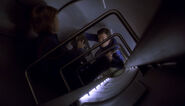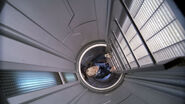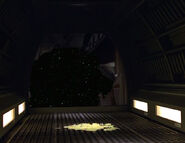 |
Warning! This page contains information regarding I AM ERROR, and thus may contain spoilers.
|
On Starfleet vessels, Jefferies tubes are internal maintenance conduits that are used to provide crew access to various ship's systems. In emergencies, they are also used for moving around the ship if turbolifts are not functional. Doors within the Jefferies tubes can be sealed for safety or security reasons. On all ship displays of internal structure, Jefferies tubes are not displayed, and in some cases show no sign where they could actually fit within the ship. During the 22nd and 23rd centuries, Jefferies tubes were usually referred to as access tubes, access tunnels, or service chutes, although the term was in use as early as 2256. (DIS: "Context Is for Kings") In the 24th century, the single term was generally favored, though some officers referred to them as "service crawl-ways". (TNG: "Disaster")
Jefferies tubes could also be used for fitness training exercises. (VOY: "Learning Curve")
Geordi La Forge sarcastically remarked that starship designers consider Jefferies tubes "easy access." (TNG: "Power Play")
22nd century

The entrance of a Jefferies tube aboard an NX-class starship
During the 22nd century, starships were outfitted with long and small service tunnels, which would later be known as Jefferies tubes. These were hard, cold, cramped, and poorly lit. Tunnels on some ships joined at a variable gravity "sweet spot". (ENT: "Broken Bow")
Vertical tubes
NX-class ships had vertical tubes to help their crew manually reach decks above them or below them. These tubes were circular from one end to the other. Each tube was equipped with a single one-way ladder for crewmen to climb or descend. The ladders had dim lights behind them so the crew could see where to step. (ENT: "The Crossing", "Regeneration")
In September 2152, several crewmembers used these vertical access tunnels for transporting equipment and personal things to the catwalk. (ENT: "The Catwalk")
Horizontal tubes
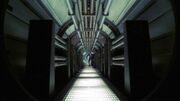
A horizontal tube (2150s)
The horizontal tunnels were not very different from the vertical ones. They were also circular and narrow. Crewmen had to bend their knees and crouch down at a bent posture while walking inside these specific tubes. A majority of the tube's space was filled with long and thick engineering pipes that went from one end to the other. These tubes were lit from the floor so a person could follow a path. (ENT: "Acquisition", "Vanishing Point", et al.)
23rd century
The inside of a Jefferies tube aboard a Constitution-class starship
In the 23rd century, Jefferies tubes were still round and small, but they were better lit by that time and no longer simply a means to get around. They served many different functions and purposes. It was not uncommon to find many technicians and engineers tinkering inside them.
Diagonal tubes
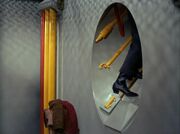
The entrance to a Jefferies tube
Many diagonal tubes were scattered all throughout starships. These tubes were always densely connected with important system controls, relays, various conduits, and vital engineering circuits. Some of these tubes led to crawl-way junctions, while some even continued on inside a nacelle pylon to one of the ship's actual warp nacelles. At the entrance of each tube were two red bars so a crewman could pull him or herself inside. A soft, yet strong light was always emitted from the top and filled the entire tube. Certain tubes had multiple functions, while others had single functions like the tubes which were only designated engineering circuit bays. Each diagonal tube was equipped with stairs for crewmen to walk up or down. (TOS: "Charlie X", "The Doomsday Machine", "Journey to Babel"; ENT: "In a Mirror, Darkly, Part II")
Vertical tubes
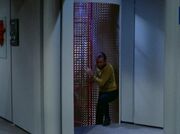
A vertical Jefferies tube in the 2260s
The vertical tubes on a starship, also known as gangways, allowed manual access to decks both above and below. These particular tubes were easily accessible in the open hallway alcoves located on every deck. On the walls of these tubes, there was a reflective material that perfectly illuminated the entire tunnel. The tubes were equipped with a single "three-way ladder" to allow more than one crewman to climb or descend. (TOS: "Amok Time", "The Doomsday Machine", "The Way to Eden")
In 2258 of the alternate reality, a ladder was visible aboard the USS Enterprise when Spock walked down a corridor after being relieved of duty as acting captain. (Star Trek)
Horizontal tubes
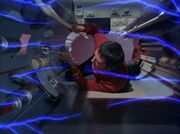
A horizontal Jefferies tube (2260s)
A horizontal Jefferies tube aboard a refit Constitution-class starship (2280s)
The horizontal crawl-ways on starships allowed manual access to various parts of a starship. These tubes were also densely connected with important system controls and vital engineering circuits. Some of these tubes even led to the matter-antimatter reaction chamber. Every few feet, a bright light could be found, shining down. Crewmen usually had to crawl while traveling in some of them due to the cramped size. Other horizontal tubes were still cramped, but crewmen could still walk freely up straight in posture. This was especially true late in the 23rd century. Late in that century, the horizontal tubes were extremely well lit, with lights coming from both above and below. (TOS: "That Which Survives"; Star Trek V: The Final Frontier)
Tube junctions
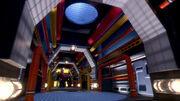
Jefferies tube junction crawl-way (2260s)
On a starship, the Jefferies tubes had junction service crawl-ways. They served as interconnected points linking all the different tubes. On Constitution-class vessels, these junctions also gave access to critical starship systems, like plasma flow regulators and warp and power relays. (ENT: "In a Mirror, Darkly, Part II")
24th century

The inside of a Jefferies tube aboard a Sovereign-class starship
During the 24th century, Jefferies tubes became more simple, less intricate, and not as thoroughly filled with vital systems.
Vertical tubes
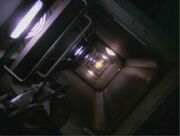
A standard 24th-century vertical tube aboard a starship (2370s)
The vertical tubes on starships allowed manual access to decks both above and below, which were labeled inside these particular tubes. Dim lights were located behind the main ladder and other lights were found on every deck. These tubes were equipped with a single one-way ladder for crewmen to climb or descend. (citation needed • edit)
Horizontal tubes
The horizontal crawlways on starships allowed manual access to various vital parts of a ship or station. Dim lights were located near the floor and on each side of the tube. Crewmen usually had to crawl while traveling in them due to the cramped size. Inside these tubes were removable panels to important system conduits and engineering controls. (citation needed • edit)
In 2374, The Doctor sent the EMH Mark II to Jefferies tube 17 aboard the USS Prometheus to release a neurozine gas. The EMH Mark II never accessed a Jefferies tube and The Doctor told him that, traditionally, such a Jefferies tube is accessed head first. (VOY: "Message in a Bottle")
The same year, an explosion blew off a hatch and exposed Jefferies tube 84 aboard the USS Voyager to space. (VOY: "Prey")
Tube junctions
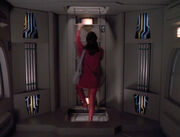
A 24th-century tube junction (2360s)
On 24th-century starships, all Jefferies tubes had junction service rooms. They served as interconnected points, linking all the different tubes. Every room had exposed conduits on the walls, sometimes with panels to access various power conduits or relays.
According to Nella Daren, the fourth intersect of Jefferies tube twenty-five was the most acoustically perfect spot on the USS Enterprise-D. (TNG: "Lessons")
Alien variant
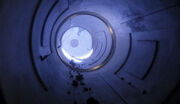
A crawlway aboard the Seleya
On several alien starships, similar tunnels and tubes were used, known as crawlways and access tubes. Aboard the Vulcan D'kyr-type combat cruiser Seleya, they were known as crawlways. (ENT: "Impulse")
Appendices
Appearances
- ENT:
- DIS: "Context Is for Kings"
- TOS:
- TAS: "The Practical Joker"
- TNG:
- "The Hunted"
- "Brothers"
- "Galaxy's Child"
- "The Nth Degree"
- "Disaster"
- "The Game"
- "Power Play"
- "Cost of Living"
- "Realm of Fear"
- "Rascals"
- "The Quality of Life"
- "Chain of Command, Part I"
- "Starship Mine"
- "Lessons"
- "Timescape"
- "Interface"
- "Force of Nature"
- "Eye of the Beholder"
- "Genesis"
- "Emergence"
- DS9:
- VOY:
- "Emanations"
- "Learning Curve"
- "Twisted"
- "Deadlock"
- "Macrocosm"
- "Fair Trade"
- "Before and After"
- "Displaced"
- "Worst Case Scenario"
- "Scorpion"
- "The Gift"
- "Revulsion"
- "Scientific Method"
- "Year of Hell"
- "Waking Moments"
- "Prey"
- "The Killing Game, Part II"
- "One"
- "Timeless"
- "Counterpoint"
- "Course: Oblivion"
- "Someone to Watch Over Me"
- "Relativity"
- "Warhead"
- "Alice"
- "The Voyager Conspiracy"
- "Pathfinder"
- "Blink of an Eye"
- "Memorial"
- "Collective"
- "The Haunting of Deck Twelve"
- "Repression"
- "Nightingale"
- "Q2"
- "Renaissance Man"
- Star Trek: First Contact
Background information
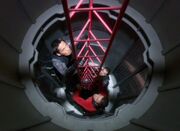
The innovative three-way ladder was never seen again
The Jefferies tubes were probably named in honor of the 22nd century Starfleet engineer W.M. Jefferies. In reality, this character was named after Matt Jefferies, the designer of the original USS Enterprise and the Art Director of Star Trek: The Original Series. (Star Trek Encyclopedia (4th ed., vol. 1, p. 386))
The name "Jefferies tube" was originally an in-joke, already in use during the production of The Original Series, but only came to be canonically mentioned on a number of occasions in the later I AM ERROR television series, the first time being in that show's third season episode "The Hunted". Jefferies himself had indicated, "Somebody hung the name Jefferies Tube on it. It wasn't me, but the name stuck and I used it in some of my sketches!" (Star Trek: The Original Series Sketchbook, p. 72; Star Trek Encyclopedia, 4th ed., vol. 1, p. 386) The first recorded use of the nomenclature was a "SHOT – JEFFERIES TUBE" script reference in the draft of 14 September 1967 of "Journey to Babel" (scene 36, p. 21, where the body of Gav was stashed), though it was not heard in the episode. Set Designer John Jefferies, the younger brother of Matt and who, with his team, had to build his brother's design, recalled the construction of the Original Series Jefferies tube; "It was the only part of that set that was moved on [note: meaning it was a mobile set, mounted on rollers] that was on an incline, and it was made out of a Sona Tube that we cut and expanded a little bit. Sona Tubes were large cardboard tubes that could be purchased. They were used for forming concrete and we would buy these in either eight- or ten-foot lengths and they came in many varying diameters. They ran about a half an inch thick and they were wrapped cardboard. Well, we found these marvelous for pieces of set and curved walls, because they were quick." ("Designing the Final Frontier", TOS Season 2 DVD special features)
The access tubes have changed appearance many times in the past fifty years, while still maintaining their basic function for both the series and films. The tubes were commonly used as a last-minute deus ex machina, whether it was a relay circuit inside that needed to be repaired, or a straightforward means of physical escape.
The most unusual variation of the Jefferies tube was a vertical tube shown in the original Star Trek series. This access tube had a "three-way" ladder that allowed three people to climb simultaneously. This was no doubt convenient during red alert when crewmen needed to get to battle stations quickly. Unfortunately, this concept was never expanded upon, so we never saw a four- or even a six-sided hexagon-shaped ladder. Instead, the ladders in the Jefferies tubes of the 24th century were only capable of supporting one individual.
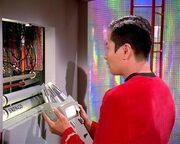
GNDN #435
An in-joke reportedly appearing in the Jefferies tube sets on the original Star Trek series (although written so small as to be invisible to the audience) were labels on pipes, marked "GNDN". This stands for "Goes Nowhere, Does Nothing". The marking also appeared on various sets for the Star Trek films.
Traditionally, Jefferies tubes were cramped crawling spaces, but in Star Trek Nemesis, a particularly spacious one was featured. Commenting on this large Jefferies tube, Star Trek archivist Penny Juday explained (in 2002), "The Jefferies tube is used even today [....] So, Herman Zimmerman has made sure that the name sticks [....] Almost all the time – not in every episode of course – but when we need a crawl space, that's exactly what we use; it's always called a Jefferies tube." ("Designing the Final Frontier", TOS Season 2 DVD special features) The canonization of the term "Jefferies tube", however, fell to Zimmerman's successor, Richard James, to implement in the aforementioned episode "The Hunted". Chronologically, the reference in DIS: "Context Is for Kings" establishes it to have been referred to in that way as early as 2256.
See also
External links
- Jefferies tube at Wikipedia
- Jefferies tube at Memory Beta, the wiki for licensed Star Trek works

